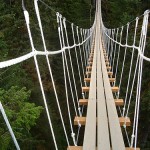 “The whole entire world is a very narrow bridge….and the main thing is not to be ruled by fear.”
“The whole entire world is a very narrow bridge….and the main thing is not to be ruled by fear.”
-Rebbe Nachman of Breslov, 18th century Ukranian Hasidic mystic
My lab studies hydrocephalus, probably the most commonly treated pediatric neurosurgical condition. Most people think hydrocephalus was solved 50 years ago with invention of the shunt. But the kids I see with brain water problems, and their parents, don’t think the challenge is over. They ask: Why do I keep having headaches? Why do I keep having operations? Hydrocephalus needs new thinking, new imaging, new drugs, new interest. Our patients want us to innovate, and come up with something better.
In an area like hydrocephalus, with only a handful of researchers trying to make the world better, clinical innovation comes up against a rate-limiting step – the high, scary, often shaky bridge between basic discovery and clinical breakthrough. We call this translational research. The really big advances may depend on the folks who can build the bridges between these two peaks, and then delight in living on them.
New drugs, devices, surgical procedures, and (probably most importantly) changes in how we think about a disease process, all need bridge builders and bridge crossers. As with translating from one language to another, translational research requires mastery of two or more vocabularies, two grammars and maybe two cultures to make a conversation possible. But the translational researcher does more: adding ideas, questions and new experiments and discoveries that may fall outside the range of traditional basic or clinical research.
In November of 2006, at a Surgery/Anesthesiology Grand Rounds, I gave a presentation on new ways to think about the physics of pressure and fluid flow in the brain as it relates to hydrocephalus. The late Dr. Judah Folkman was in the audience, and asked a question about a vessel-targeting molecule that he thought might play a role in hydrocephalus.
Dr. Folkman knew how to build bridges, and, judging from his trainees and protégés, he knew how to teach the art. Within weeks we were testing cerebrospinal fluid from patients, and at least the first test supported his conjecture about a new pharmacologic way to treat the condition. Following on his lead has made us think about the responses of the brain blood vessels to these molecules, and more recently, the frilly ciliated cells that line the brain-fluid spaces. I’m as certain as Dr. Folkman was that we will someday see a dramatically different treatment for kids with brain water problems—but we will only see the connection from the bridge.
We need to teach more young docs to live on the bridge, love the view, and not fear. But how do we teach this key skill? Is it even possible?
The two peaks at either end of the bridge are well defined. For a basic-science researcher, the path to the summit might be: Find a laboratory that excels in the techniques of unlocking deep and difficult secrets. Study the techniques with a master. Earn a PhD degree. Rise through a series of grant awards, over years, to run a lab yourself. Publish in Nature and Science.
Training in clinical research takes a different path: Develop a skill set in biostatistics and epidemiology. Find large patient populations to study. Develop strong hypotheses about natural history of disease, response to treatment, cost effectiveness, clinical effectiveness. If you have an MD degree, consider a Masters of Public Health or equivalent degree. Publish in JAMA and NEJM.
The summits of these educational peaks are individually spectacular, and the climb to either summit is difficult and rewarding. The same is true for translational research, except there’s no clearly defined path of travel, and no systematic training approach. It may be hard to find a mentor, research funding and a place to publish, and to get recognition.
Mapping the human genome was a monumental achievement — a seismic thrust of a new mountain peak into the sky. But bridges to the opposite peak have yet to be built, so we still read headlines like this from The New York Times: “A Decade Later, Genetic Map Yields Few New Cures.”
Sometimes we can be nudged into action by an unexpected source. Almost two decades ago, when I was a young attending here, I explained slit ventricle syndrome, a kind of shunt problem, to the parents of a young patient, using the same physical explanation that most neurosurgeons still use. The problem was that the mother was an engineer, and the father a professor of physics. He gently replied to me: “You know, Doctor, what you just said does not make any physical sense.”
They were right—and our conventional understanding was wrong. Slowly we realized that our attempts to understand hydrocephalus and shunts required a deeper understanding of dynamic, changing, pulsatile phenomena. Linking the physics, the biology, and clinical intuition has become a wonderful passion. For me, a high and narrow bridge is a great way to view things.
The last thing patients want is for us to stay off the bridge because the height and wind make it scary. In future posts, I would like to think about the bridges, the builders, and the people who like to live on bridges. We must learn and teach how not to fear.







